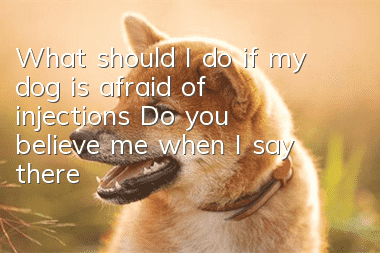What should I do if my dog is afraid of injections? Do you believe me when I say there are dogs who like injections?

Dogs should practice in advance if they are afraid of injections
1 Make the syringe a good thing
Put the syringe in front of the dog, and when it notices the syringe, immediately reward it with a small piece of food.Training frequency: 5-10 times a day (performed before each injection, with an interval of 5-10 minutes between each time).
2 First "drill" with a syringe without a needle
When the syringe touches the dog's body, as long as it does not show strong discomfort, immediately press the clicker and reward it.3 Change to a sharp object to simulate the injection
Change to a sharper object such as a pen tip or a paper clip, and touch the dog to truly simulate the pain of the injection. Be careful to make sure the substitute is sterile and harmless. Also start with contact and click until the dog shows no strong resistance, press the clicker and give a reward.During the process, slowly increase the intensity based on the dog’s performance. After each increase in intensity, if it does not conflict, give a double reward.
4 Extend the contact time between sharp objects and the body
When the dog also expresses OK with sharp objects, the next step is to extend the contact time between these objects and its body. Because the injection often takes about 5-8 seconds to complete.If the contact time in the previous step has been maintained at 0.5 seconds, then increase it from 0.5 seconds to 1 second. Don’t be too greedy when you first start. Just make a little progress each time than last time. As long as there is progress, press the clicker immediately and give rewards, and gradually extend the contact time.
5 Change to a real syringe needle
Based on the previous steps, start the actual injection. During the injection process, food should also be used to strengthen the dog's stability.Balding methods for dog injections
There are two methods often used by medical staff: Baoding and anesthesia.1 Baoding
Refers to the protective measures taken by artificial methods to make animals easier to receive diagnosis and treatment and to ensure the safety of humans and animals. Animal restraint is one of the basic operational skills that veterinary practitioners (especially epidemic prevention personnel) should possess. There are different restraint methods for different animals. Common methods of restraining dogs: mouth mesh restraint, mouth restraint restraint, horizontal restraint restraint, etc.2 Anesthesia
Commonly used techniques when animals receive some treatments, mostly in surgeries and in-depth examinations of animals. Used to eliminate pain and discomfort in animals. It can ensure the safety of animals, make them obey the operation during the treatment process, and ensure the smoothness of treatment.But the problem with anesthesia is that the cost is too high, both in terms of drug cost and time cost. For example, pug Soy Milk only needs two injections of insulin every day, so using anesthetics would be a bit laborious.
Dogs can “tolerate” injectionsDoes it hurt?
Just like children who cry and struggle when they are afraid of injections, the dog's reaction is completely due to animal nature. To prevent your dog from biting during the injection, you can use "binding methods" to limit its range of motion, such as Elizabethan rings, masks, or others. (Restraint method: During diagnosis and treatment, the dog may bite or scratch the medical staff, or the diagnosis and treatment operations may be affected due to commotion, so appropriate restraint should be provided.)But such a rough method is not suitable for dogs who often receive injections. This will cause Let the object of its fear be generalized, from the initial syringe to a circle of shame, a mask, and even the owner; the problem will not only not be solved, but will become more serious.
How much pain can a dog tolerate?
Dogs often suffer injuries during fights, but this does not mean that dogs are not afraid of pain. Some behaviorists believe that dogs show better pain tolerance in outdoor environments than indoors because their canine ancestors used to do so, otherwise their lives may have been lost!When canines are in the wild, they will do their best to hide their pain, otherwise they are likely to be regarded as a burden and abandoned! And dogs acting alone should pretend to be tough, so they have a greater chance of survival!
Different individuals have different tolerances for different levels of pain. Even within the same dog, different parts of the body have different tolerances for pain. Some breeds are famous for their high pain tolerance, especially the breeds that were first used as fighting dogs, which are particularly outstanding in this aspect.
For example, the Shar-Pei has a unique coat that feels rough to the touch, extremely thick skin, and rich wrinkles, and has a particularly high tolerance for pain!
Random articles
- Dogs born in Alaska and Samos also have many advantages.
- What should I do if my dog is bitten by a tick?
- The little puppy keeps meowing at night. Are you taking good care of it?
- What is the reason for the black and smelly dog poop? Are you still worried about the black and smelly dog poop?
- My dog pooped 8 times at night. Do you know what went wrong?
- How to improve your dog’s immunity. You might as well pay attention to improving your dog’s immunity!
- Can dogs eat bananas if they have constipation? Bananas also have a big effect
- What to do if your dog doesn’t like to drink water? Let your dog take the initiative to drink water
- Who is not suitable for raising a dog? These three types of people advise you to be kind and not raise a dog.
- Does a puppy need to be vaccinated if it bites? Treat rabies vaccine correctly



